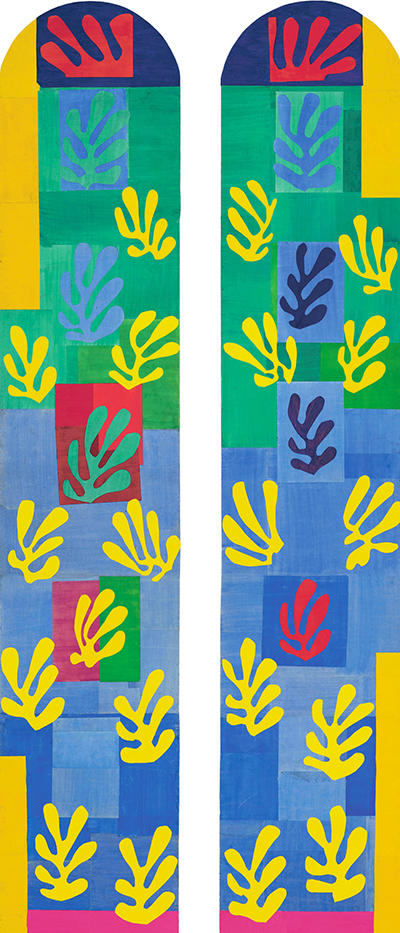Pale Blue Window is a two piece design for a pair of narrow windows. Matisse was interested in re-inventing this traditional art form which had been popular across the UK and France in previous centuries. His approach was very different, replacing intricate portraits with simplified natural shapes.
Henri Matisse produced a number of stained glass window designs, including also Nuit de Noel. He would incorporate his natural shapes and reduced palette in order to produce highly contemporary scenes which in these cases were the right shape to fit the arched windows used for stained glass. The art form itself was popular up to around the 19th century but after that point there was less finance available for it within religious circles. It was also a particularly specialised genre and some of these skills would be lost as the tradesmen passed away. Whilst being entirely charming, stained glass window design was fraught with technical challenges and its fragile nature has also made it hard to preserve. Matisse wanted to refresh the genre with his own ideas, and was always able to somehow make his existing style work across different disciplines.
The artist here delivers a series of natural shapes patterned across the two window panels. He covers most of the background with tones of blue and green, transitioning from one to the other as we move vertically through the piece. There are also blocks of yellow slipped into the corners of both narrow forms. The natural shapes themselves resemble a generic multi-leaved plant such as a succulent or perhaps some of the marine growth that can be found on the foot of the ocean. Most of them are delivered in yellow, but a few are in blue and red to provide a contrast. The overall effect is bright and upbeat, as well as highly contemporary and starkly different to the more traditional styles of stained glass windows.
This talented French painter would work tirelessly throughout his career with the bold ambition of taking his natural abilities just as far as they could go. Although his style was consistent after he completed his early stages of development, it was in the mediums that he used in which he really showed the most variety. He enjoyed figurative art and mastered it brilliantly, though standard portraits were also common whilst he worked in oil. Elements from nature then became a sort of visual language that could provide patterns in his later work, and that was also when he started to use cut-out techniques fairly regularly. In all, he left behind one of the most influential careers in the early periods of modern art, and helped to shape this exciting new period in the art world.




